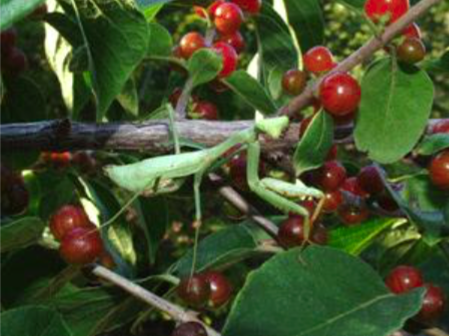Insects can be a real nuisance to our lives. They feed on our plants, eat our vegetables before we can, and invade our homes. However, not all insects are bad insects. Some are a beneficial insect, which means that they are helpful to us by feeding on other insects that are damaging or problematic. One type of those beneficial insects is praying mantises.
Praying mantises, or praying mantids, show up during the fall of each year. This is the time of the year when they are fully mature and working on mating and laying eggs before the winter. There are two most commonly seen types of mantids that we will find in the Nebraska environment, Carolina mantids and Chinese mantids. These are both fairly large mantids, but the Chinese mantid is much larger, they can grow more than four inches long, where the Carolina mantid only grows to just over two inches long. Chinese mantids are the mantids that most people notice because they are so large.
In the fall mantids will lay their eggs in an egg case, called an ootheca (pronounced ō-ə-ˈthē-kə). These look slightly different depending on the species of mantid that lays the egg case. With the Carolina mantid, the egg case is frothy, flat and smaller, it looks like a weird growth on the branch that is tan in color and has many lines through it. The ootheca for Chinese mantids looks
similar to a Chinese lantern. It is about the size of a half dollar and is an oddly shaped structure that is also tan and frothy, but this type of ootheca hangs down from the branch. I always think that mantid egg cases look similar to that expanding foam you put into cracks in the wall or beside window frames. Each of these egg cases contain up to two hundred eggs. In the spring the nymphs will emerge, almost in swarms, and they look like tiny versions of adult mantids.
Like I said, praying mantids are not harmful insects. They can bite people, but usually that only occurs if you are holding one and it reaches around to your finger. Mantids can turn their heads over 180 degrees and they are very quick and have spines on their front legs which allows them to be able to catch their prey easier. They do not prey on people and they do not feed on our plants or live in our homes over the winter. They will feed on many other smaller insects that are bad for our plants and they will feed on each other. The nymphs will eat each other if there is nothing else around for them to eat when they emerge from their egg case. The female will eat the male following copulation; many entomologists believe this is so the female has enough nutrients and energy to produce the offspring.
If you find praying mantid egg cases on your plants, you should leave them alone. Do not take them off of the tree because if they are left on the ground, they can be attacked by ants, killing all the offspring. These insects are great to have around because they may eat enough of your “bad bugs” to keep you from having to spray insecticides. If you have mantids around and you do have an insect problem on those plants, you should try to use less harmful chemicals to avoid killing off all of the beneficial insects.


